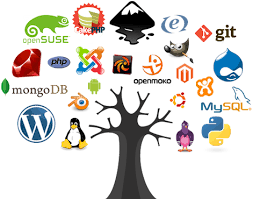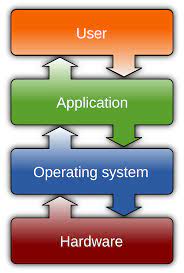Unleashing the Potential: The Power of Open-Source Software
The Power of Open-Source Software
In today’s digital age, open-source software has emerged as a powerful force that is transforming the way we interact with technology. From operating systems and web browsers to productivity tools and databases, open-source software has become an integral part of our daily lives. But what exactly is open-source software, and why is it gaining such popularity?
Open-source software refers to computer programs whose source code is freely available for anyone to view, modify, and distribute. Unlike proprietary software, which is developed and controlled by a single entity, open-source projects are collaborative efforts driven by a community of developers who contribute their skills and expertise voluntarily.
One of the key advantages of open-source software lies in its transparency. With access to the source code, users can examine how the program works, identify any bugs or vulnerabilities, and even suggest improvements. This transparency fosters a sense of trust and accountability within the community.
Collaboration is at the heart of open-source development. Developers from around the world come together to share their knowledge and work collectively on projects. This collaborative nature leads to faster innovation as ideas are exchanged freely, resulting in more robust and feature-rich software.
Open-source software also promotes customization and flexibility. Users have the freedom to modify the software according to their specific needs or preferences, allowing for greater personalization. This adaptability makes open-source solutions ideal for businesses that require tailored solutions or individuals seeking a more personalized computing experience.
Another significant advantage of open-source software is its cost-effectiveness. Since it can be freely accessed and distributed, users can save substantial amounts on licensing fees compared to proprietary alternatives. This accessibility also ensures that open-source solutions are available to a broader audience regardless of financial constraints.
Security is another aspect where open-source shines. With many eyes scrutinizing the code for vulnerabilities or backdoors, issues can be identified quickly and resolved promptly. The collaborative nature of development means security patches are released regularly, ensuring that software remains secure and up-to-date.
Open-source software has also played a crucial role in fostering innovation. By providing a platform for developers to experiment, create, and share their work freely, open-source projects have given birth to groundbreaking technologies and ideas. The success of projects like Linux, Apache, and Firefox demonstrate the power of open-source in driving innovation.
As open-source software continues to gain traction, it is important to recognize its potential beyond the realm of technology. Open-source principles can be applied to various domains such as education, healthcare, and government. By embracing openness and collaboration, these sectors can benefit from shared knowledge and resources, leading to more efficient systems and improved outcomes.
In conclusion, open-source software is revolutionizing the digital landscape by offering transparency, collaboration, customization, cost-effectiveness, security, and innovation. Its impact is felt across industries and communities worldwide. As we move forward into an increasingly interconnected world, embracing the power of open-source will undoubtedly shape the future of technology for the better.
9 Essential Tips for Using Open-Source Software
- Research the software before you use it – read reviews, check out forums and ask questions to make sure it’s right for you.
- Make sure you understand the license agreement and any restrictions that may apply to your use of the software.
- Check whether there is an active online community providing support and updates for the software you’re considering using.
- Consider how easy it will be to upgrade or migrate away from the open source software if needed in future, as this may not always be possible with some open source solutions.
- If security is a concern, look into what security measures have been implemented in the development of the open source software and whether regular updates are released to keep up with changing threats and vulnerabilities.
- Always back up your data before installing any new piece of software onto your system, even if it’s open-source!
- Watch out for malicious code hidden in some versions of open-source software – make sure you only download from reputable sources such as official websites or trusted app stores, rather than third-party sites offering downloads which could contain malicious code or viruses disguised as legitimate files/programs etc..
- Avoid downloading large amounts of data when using open-source applications as this can cause performance issues on slower internet connections or computers with limited RAM/processing power etc..
- Don’t forget to check out other options available – there may be better suited proprietary alternatives available that could meet your needs more effectively than an open-source solution!
Research the software before you use it – read reviews, check out forums and ask questions to make sure it’s right for you.
Researching Open-Source Software: Making Informed Choices
In the vast landscape of open-source software, where countless options are available at your fingertips, it’s crucial to make informed decisions before diving in. Taking the time to research and evaluate a piece of software can save you from potential headaches down the road. Here are some tips to help you navigate the process and ensure that the software you choose is right for you.
First and foremost, reading reviews can provide valuable insights into a particular open-source software. Look for reviews from reliable sources or trusted community members who have hands-on experience with the software. Their feedback can shed light on its performance, usability, features, and any potential drawbacks. Keep in mind that no software is perfect, but by understanding its strengths and weaknesses, you can make an informed decision.
Forums dedicated to open-source communities are treasure troves of information. Explore these platforms where users discuss their experiences with various software options. By browsing through forum threads related to your chosen software, you may find answers to questions you didn’t even know you had. Engage with the community by asking specific queries or seeking clarification on any concerns you may have. The collective knowledge of these forums can be invaluable in helping you gauge whether a particular open-source solution aligns with your needs.
Don’t hesitate to ask questions directly to developers or project maintainers if possible. Many open-source projects have active communities that welcome inquiries from potential users. Reach out via email or participate in developer mailing lists or chat channels associated with the software. By engaging with those involved in its development, you gain insights into their vision, roadmap, and level of support provided.
Consider compatibility with your existing technology stack or requirements when evaluating open-source software options. Ensure that it integrates seamlessly with other tools or systems that are critical to your workflow. Compatibility extends beyond technical aspects; it also includes licensing considerations and community support for long-term sustainability.
It’s important to remember that open-source software thrives on community participation and collaboration. Take note of the project’s activity level and the responsiveness of its developers to bug reports, feature requests, and security updates. Active projects with regular releases demonstrate a commitment to improvement and maintenance.
Lastly, trust your instincts. If something doesn’t feel right or if you have reservations about a particular software, it’s worth exploring alternatives or seeking further clarification. Open-source software offers a wide range of options, so take the time to find the one that best suits your needs and aligns with your values.
In conclusion, researching open-source software before using it is vital for making informed choices. Reading reviews, engaging with communities through forums, asking questions directly to developers, considering compatibility, and trusting your instincts are key steps in this process. By investing time upfront in research and evaluation, you can ensure that the open-source software you ultimately choose is the right fit for you and your specific requirements.
Make sure you understand the license agreement and any restrictions that may apply to your use of the software.
Understanding Open-Source Software License Agreements
When it comes to using open-source software, it’s essential to familiarize yourself with the license agreement and any associated restrictions. While open-source software grants users certain freedoms, it is still governed by licenses that outline the terms and conditions for use. Here’s why understanding these license agreements is crucial.
Open-source licenses come in various forms, each with its own set of provisions. Some licenses, like the GNU General Public License (GPL), require that any modifications or derivative works be released under the same license. Others, such as the MIT or Apache licenses, offer more flexibility by allowing users to incorporate the software into proprietary projects.
By taking the time to read and comprehend the license agreement, you can ensure that your use of open-source software aligns with its intended purpose. This means avoiding unintended violations that could result in legal consequences down the line.
License agreements may contain restrictions or obligations that you need to be aware of. For example, some licenses require you to provide attribution or include a copy of the license when distributing the software. Others may prohibit using the software for certain purposes or in specific contexts.
Understanding these restrictions is vital for both individuals and organizations. It enables you to make informed decisions about how you can use and distribute open-source software while respecting its licensing terms. By doing so, you contribute to maintaining a fair and sustainable open-source ecosystem.
Additionally, comprehending license agreements helps protect your intellectual property rights. It ensures that your contributions are appropriately recognized and respected within the open-source community.
To understand a license agreement better:
- Read through it carefully: Take your time to go through each section of the license agreement, paying attention to any specific requirements or limitations mentioned.
- Seek legal advice if needed: If you’re uncertain about any aspect of an open-source license agreement, consider consulting legal professionals who specialize in intellectual property or open-source licensing.
- Engage with the open-source community: Participate in forums or discussions related to the software you are using. Engaging with the community can help clarify any doubts and provide insights from experienced users.
- Stay updated: Keep track of any updates or changes to the license agreement for the software you are using. Open-source projects may occasionally update their licenses to address emerging issues or improve clarity.
By understanding open-source software license agreements, you can navigate the open-source landscape confidently, ensuring compliance and maximizing the benefits of using open-source solutions. Remember, knowledge is key when it comes to leveraging open-source software effectively and responsibly.
Check whether there is an active online community providing support and updates for the software you’re considering using.
The Importance of an Active Online Community in Open-Source Software
When considering using open-source software for your projects or daily tasks, one crucial tip is to check whether there is an active online community supporting and providing updates for the software you’re considering. The presence of a vibrant and engaged community can greatly enhance your experience and ensure the longevity of the software’s development.
An active online community offers numerous benefits to users. Firstly, it serves as a valuable resource for support. Whether you encounter technical issues, have questions about functionality, or need guidance on how to optimize the software for your specific needs, an active community can provide the assistance you require. Members of the community are often experienced users or developers who willingly share their knowledge and expertise, helping you overcome challenges more efficiently.
Additionally, an active community ensures that the software remains up-to-date with regular updates and bug fixes. Open-source projects thrive on collaboration, and when a community is actively involved, developers are more likely to continue improving and enhancing the software over time. Updates not only introduce new features but also address security vulnerabilities and improve overall performance. By staying connected to an active online community, you can stay informed about these updates and ensure that you are using the most stable and secure version of the software.
Furthermore, being part of an online community provides opportunities for networking and collaboration. You can connect with like-minded individuals who share similar interests or work in related fields. This fosters knowledge sharing, idea exchange, and potential collaborations on future projects. The power of a collective effort within an open-source community often leads to innovative solutions that benefit all users.
To check whether there is an active online community supporting your chosen open-source software, look for dedicated forums, mailing lists, chat channels or social media groups associated with that particular project. Explore these platforms to gauge their activity levels – Are there recent discussions? Are questions being answered promptly? Are developers actively engaging with users? These indicators can help you determine the community’s vibrancy and involvement.
In summary, when considering open-source software, it is essential to assess whether there is an active online community providing support and updates. This engaged community can provide invaluable assistance, ensure the software’s continuous improvement, and offer opportunities for collaboration. By becoming part of such a community, you gain access to a wealth of knowledge and resources that can enhance your experience and productivity with the software.
Consider how easy it will be to upgrade or migrate away from the open source software if needed in future, as this may not always be possible with some open source solutions.
Considering Future Upgrades and Migration in Open-Source Software
When exploring open-source software solutions, it’s crucial to consider the ease of future upgrades or potential migration away from the chosen platform. While open-source software offers numerous advantages, it’s important to acknowledge that not all solutions are created equal in terms of flexibility and compatibility.
One of the significant benefits of open-source software is its ability to evolve and adapt over time. Communities of developers constantly work on improving and enhancing these solutions, providing regular updates and new features. However, it’s essential to assess whether the chosen open-source software can accommodate future upgrades seamlessly.
Upgrades are necessary to keep up with technological advancements, security patches, and bug fixes. Therefore, it is vital to choose a solution that has an active community behind it, ensuring ongoing development and support. This ensures that you can continue to receive updates and improvements as technology progresses.
Additionally, considering the potential need for migration away from the chosen open-source software is equally important. While you may find a solution that perfectly suits your current requirements, business needs or circumstances might change in the future. It is essential to evaluate how easily you can transition away from the platform if necessary.
Some open-source solutions may have dependencies or proprietary formats that make migration challenging. It’s advisable to opt for software that adheres to widely accepted standards and formats, ensuring compatibility with other systems or tools. This flexibility allows for a smoother transition should the need arise.
Furthermore, assessing the availability of alternative options within the same domain is crucial when considering future migration. Having multiple viable alternatives ensures that you have options available should your current open-source solution no longer meet your needs.
While not all open-source solutions may guarantee effortless upgrades or seamless migration possibilities, conducting thorough research before adopting any software can mitigate potential challenges down the line. Engaging with online communities or seeking expert advice can provide valuable insights into a particular solution’s upgradeability and migratability.
In summary, when considering open-source software, it is wise to evaluate the ease of future upgrades and potential migration away from the chosen platform. Selecting a solution with an active community, adherence to standards, and alternative options within the same domain can help ensure long-term flexibility and compatibility. By carefully considering these factors, you can make informed decisions that align with your current needs while keeping future possibilities in mind.
If security is a concern, look into what security measures have been implemented in the development of the open source software and whether regular updates are released to keep up with changing threats and vulnerabilities.
Ensuring Security in Open-Source Software
When it comes to open-source software, one of the key considerations for users is security. While the collaborative nature of open-source development can enhance security through community scrutiny, it’s important to take extra measures to ensure that the software you choose is secure and protected against emerging threats and vulnerabilities.
If security is a concern, it is crucial to delve into the security measures implemented during the development of the open-source software. Start by researching the project’s documentation, website, or community forums to understand how seriously they prioritize security. Look for information on their security practices, such as code reviews, vulnerability assessments, and encryption protocols.
Regular updates are another significant aspect to consider. Open-source projects that actively release updates demonstrate their commitment to addressing security concerns promptly. Regular updates not only introduce new features but also address any identified vulnerabilities or weaknesses. By keeping your software up-to-date with these releases, you ensure that your system remains resilient against evolving threats.
Additionally, it is worth exploring whether the open-source project has a dedicated security team or community that actively monitors and responds to security issues. A proactive approach towards addressing vulnerabilities indicates a commitment to maintaining a secure software ecosystem.
Furthermore, consider checking if the project has a bug tracking system or a public record of reported vulnerabilities and their resolutions. This transparency allows users to assess how effectively potential risks are being managed by the development team.
In some cases, you may find open-source projects that undergo external audits or have partnerships with reputable organizations focused on ensuring code integrity and security compliance. These additional layers of scrutiny provide an extra level of assurance regarding the trustworthiness of the software.
Lastly, it can be valuable to assess whether there is an active user community around the open-source project discussing security-related topics. Engaging with this community can provide insights into real-world experiences and best practices for securing and configuring the software effectively.
By considering these factors related to security measures and regular updates, you can make informed decisions when selecting open-source software. Remember, while open-source projects benefit from collaborative development and transparency, it is essential to be proactive in ensuring the security of the software you choose.
Always back up your data before installing any new piece of software onto your system, even if it’s open-source!
The Importance of Backing Up Your Data with Open-Source Software
When it comes to installing new software, even if it’s open-source, it’s always wise to take precautions and back up your data. While open-source software is generally reliable and trustworthy, unforeseen circumstances can still occur during installation or usage that may lead to data loss or corruption. By following this simple tip of backing up your data, you can safeguard yourself against potential mishaps and ensure the safety of your valuable information.
Open-source software offers numerous benefits, including transparency, security, and customization. However, no software is entirely immune to glitches or errors. During the installation process, conflicts may arise with existing files or configurations on your system. In rare cases, these conflicts can result in unintended consequences that could potentially affect your data.
By backing up your data before installing any new piece of software, you create a safety net that allows you to recover quickly in case anything goes wrong. Whether it’s documents, photos, videos, or any other important files, having a backup ensures that you won’t lose valuable information during the installation process.
Additionally, backups provide peace of mind when experimenting with new software. Open-source projects often undergo continuous development and updates. While these updates generally improve functionality and security, they can occasionally introduce unexpected issues. By backing up beforehand, you have the freedom to try out new software without worrying about irreversible consequences.
Backing up your data is not a complicated task. There are various methods available depending on your preferences and needs. You can use external storage devices like USB drives or external hard drives to make copies of important files manually. Alternatively, automated backup solutions or cloud storage services offer convenient options for seamless data protection.
Remember that regular backups are crucial even after installing new software successfully. It’s good practice to establish a routine backup schedule for all your important files. This way, you’ll always have an up-to-date copy in case of any future mishaps, whether related to software installation or other unforeseen events.
In summary, while open-source software is generally reliable, it’s essential to take precautions and back up your data before installing any new software onto your system. By doing so, you protect yourself from potential data loss or corruption that may occur during the installation process. Backing up your data is a simple yet effective way to ensure the safety and availability of your valuable information.
Watch out for malicious code hidden in some versions of open-source software – make sure you only download from reputable sources such as official websites or trusted app stores, rather than third-party sites offering downloads which could contain malicious code or viruses disguised as legitimate files/programs etc..
Staying Safe with Open-Source Software: Beware of Malicious Code
Open-source software offers a world of possibilities, empowering users with transparency, flexibility, and innovation. However, it’s crucial to be mindful of potential risks that can lurk within the open-source ecosystem. One such risk is the presence of malicious code hidden within some versions of open-source software.
Malicious code can be intentionally injected into open-source projects by ill-intentioned individuals or groups. This code may include viruses, malware, or other forms of harmful software designed to compromise your system’s security or steal sensitive information. To protect yourself and your devices from these threats, it’s essential to exercise caution when downloading open-source software.
When seeking open-source software, always ensure that you obtain it from reputable sources. Stick to official websites or trusted app stores that have rigorous security measures in place. These sources thoroughly vet the software they host to minimize the risk of distributing malicious code.
Avoid third-party websites offering downloads of open-source software, as they may not have the same level of scrutiny in verifying the integrity and safety of the files they provide. Such sites can unknowingly distribute modified versions of open-source programs that contain hidden malware or viruses disguised as legitimate files.
By downloading from official sources or trusted app stores, you significantly reduce the likelihood of encountering malicious code. These platforms prioritize user safety and regularly update their offerings to address any identified vulnerabilities promptly.
Additionally, keeping your operating system and security software up-to-date is crucial in safeguarding against potential threats. Regular updates often include patches for known vulnerabilities and security enhancements that help protect against emerging risks.
Remember, while open-source software promotes collaboration and community-driven development, it’s essential to remain vigilant about potential risks. By being cautious about where you download from and ensuring you only obtain open-source software from reputable sources, you can enjoy the benefits of this powerful technology while keeping your digital life secure.
Stay informed, exercise caution, and embrace the open-source community responsibly. Together, we can harness the potential of open-source software while safeguarding against malicious code and protecting our digital environments.
Avoid downloading large amounts of data when using open-source applications as this can cause performance issues on slower internet connections or computers with limited RAM/processing power etc..
Maximizing Performance: Tips for Using Open-Source Software Efficiently
Open-source software has revolutionized the way we interact with technology, providing us with powerful tools and applications that are freely available to all. However, when using open-source software, it’s important to be mindful of certain considerations to ensure optimal performance, especially for users with slower internet connections or computers with limited resources.
One crucial tip is to avoid downloading large amounts of data when using open-source applications. While these applications often offer a wealth of features and functionalities, downloading excessive data can strain your internet connection and lead to performance issues. This is particularly relevant for users on slower internet connections or those using computers with limited RAM or processing power.
To mitigate these challenges, consider the following strategies:
- Selectively Download Components: Many open-source applications offer modular installations, allowing you to choose which components you want to download and install. Instead of opting for a full installation that includes every feature, select only the components that are essential for your needs. This approach reduces the overall download size and minimizes strain on your system.
- Utilize Lightweight Alternatives: In some cases, open-source software may have lightweight alternatives available that consume fewer resources while still providing similar functionality. Explore these alternatives as they can significantly improve performance on systems with limited capabilities.
- Optimize Settings: Open-source applications often provide customizable settings that allow you to fine-tune their performance according to your requirements. Take advantage of these settings to optimize resource usage and prioritize essential tasks.
- Utilize Cloud or Remote Services: If your computer’s resources are limited, consider utilizing cloud-based or remote services for resource-intensive tasks. These services offload the processing power or storage requirements from your local machine, allowing you to leverage their capabilities without straining your system.
- Regularly Update Software: Open-source projects actively release updates and patches that address bugs, improve performance, and enhance security. Keeping your software up to date ensures that you benefit from these improvements and optimizations.
By following these tips, you can maximize the performance of open-source software on systems with slower internet connections or limited resources. Remember, open-source software is designed to be flexible and adaptable, so don’t hesitate to explore different configurations and options to find the setup that works best for you. Enjoy the power of open-source while ensuring an efficient and smooth computing experience.
Don’t forget to check out other options available – there may be better suited proprietary alternatives available that could meet your needs more effectively than an open-source solution!
Exploring the Alternatives: Choosing Between Open-Source and Proprietary Software
When it comes to selecting software for your specific needs, the world of technology offers a plethora of options. In the realm of open-source software, there is an abundance of powerful and versatile solutions available. However, it is crucial not to overlook the possibility that proprietary alternatives might better meet your requirements.
Open-source software has gained immense popularity due to its transparency, collaborative development, and cost-effectiveness. It empowers users to modify and customize the software according to their needs, ensuring flexibility and personalization. Moreover, the open nature of its development fosters innovation and security through community involvement.
However, it is essential to keep in mind that proprietary software also has its merits. While it may come with licensing fees or restrictions on source code access, proprietary solutions often offer comprehensive support systems, specialized features, and seamless integration with other tools. These factors can be particularly advantageous for businesses or individuals seeking specific functionalities or requiring extensive technical assistance.
To make an informed decision between open-source and proprietary software, consider a few key factors:
- Specific Requirements: Assess your needs carefully. Identify the critical features and functionalities you require from the software. Explore both open-source and proprietary options to determine which aligns more closely with your specific requirements.
- Support: Consider the level of support you may need during implementation or troubleshooting. Proprietary solutions often come with dedicated support teams ready to assist you promptly. Open-source projects may rely on community forums or documentation for support.
- Integration: Evaluate how well the software integrates with your existing systems or workflows. Proprietary solutions may offer seamless compatibility with other tools commonly used in your industry.
- Cost-Benefit Analysis: Compare the costs associated with each option against their respective benefits. While open-source software is generally more cost-effective due to its free availability, proprietary alternatives might provide additional value through tailored features or enhanced productivity.
Remember, each software decision is unique to the individual or organization. While open-source software has its undeniable advantages, it is crucial not to overlook the potential benefits of proprietary solutions. By exploring all available options and considering your specific needs, you can make an informed decision that best aligns with your goals and aspirations.
In the end, it’s about finding the right tool that meets your requirements effectively, whether it be open-source or proprietary. Embrace the freedom of choice and select the software that will empower you to achieve your goals efficiently and confidently.








